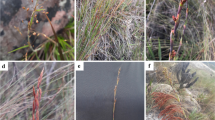Abstract
In this paper cytogenetic studies on 64 specimens from 20 Iberian populations ofCarex laevigata (Cyperaceae) are presented. Chromosome behaviour in meiosis suggests that the different chromosome numbers obtained (ranging from 2n = 69 to 2n = 80) were distributed according to an increasing geographic gradient of chromosome fission along the North → South direction. Four relatively stable areas were also delimited according to chromosome numbers displayed by this species, i.e. 2n = c. 72, c. 74, c. 76, and 78. The meiotic behaviour ofCarex ×deserta (C. laevigata ×C. binervis) was also studied.
Similar content being viewed by others
References
Cayouette, J., Morisset, P., 1985: Chromosome studies on natural hybrids between maritime species ofCarex (sectionsPhacocystis andCryptocarpae) in northeastern North America, and their taxonomic implications. — Canad. J. Bot.63: 1957–1952.
, 1986a: Chromosome studies on theCarex salina complex (Cyperaceae sectionCryptocarpae) in northeastern North America. — Cytologia51: 817–856.
, 1986b: Chromosome studies onCarex paleacea Wahl.,C. nigra (L.)Reichard, andC. aquatilis Wahl. in northeastern North America. — Cytologia51: 857–883.
Crins, W. J., Ball, P. W., 1988: Sectional limits and phylogenetic considerations inCarex sectionCeratocystis (Cyperaceae). — Brittonia40: 38–47.
Davies, E. D., 1956: Cytology, evolution and origin of the aneuploid series in the genusCarex. — Hereditas42: 349–365.
Dietrich, W., 1972: InLöve, A., (Ed.): Chromosome number reports. XXXVI. — Taxon21: 333–346.
Faulkner, J. S., 1972: Chromosome studies onCarex sectionAcutae in northwest Europe. — Bot. J. Linn. Soc.65: 271–301.
Hoshino, T., 1981a: Karyomorphological and cytogenetical studies on aneuploidy inCarex. — J. Sci. Hiroshima Univ., B2,17: 155–238.
, 1981b: Cytotypes ofCarex oxyandra and their distribution in Japan. — J. Japan. Bot.56: 220–224.
Luceño, M., 1988: Notas caricológicas, III. — Anales Jard. Bot. Madrid45: 189–196.
, 1990: Biotaxonomía del géneroCarex [Sect.Spirostachyae (Drejer)Bailey,Elatae Kük. yCeratocystis Dumort.] con especial referencia a los táxones ibéricos y norteafricanos. — Unpublished thesis. Complutense University. Madrid.
- 1991: Cytological studies on the Iberian and MacaronesianCarex species. — Willdenowia (in press).
Malheiros Gardé, N., Gardé, A., 1950: Fragmentation as a possible evolutionary process in the genusLuzula DC. — Genet. Ibérica2: 257–262.
Schmid, B., 1982: Karyology and hybridization in theCarex flava complex in Switzerland. — Feddes. Repert.93: 23–59.
Tanaka, N., 1940: Chromosome studies enCyperaceae. VIII. Meiosis in diploid and tetraploid forms ofCarex siderosticta Hance. — Cytologia11: 282–310.
Author information
Authors and Affiliations
Rights and permissions
About this article
Cite this article
Luceño, M., Castroviejo, S. Agmatoploidy inCarex laevigata (Cyperaceae). Fusion and fission of chromosomes as the mechanism of cytogenetic evolution in Iberian populations. Pl Syst Evol 177, 149–159 (1991). https://doi.org/10.1007/BF00937952
Received:
Revised:
Accepted:
Issue Date:
DOI: https://doi.org/10.1007/BF00937952




